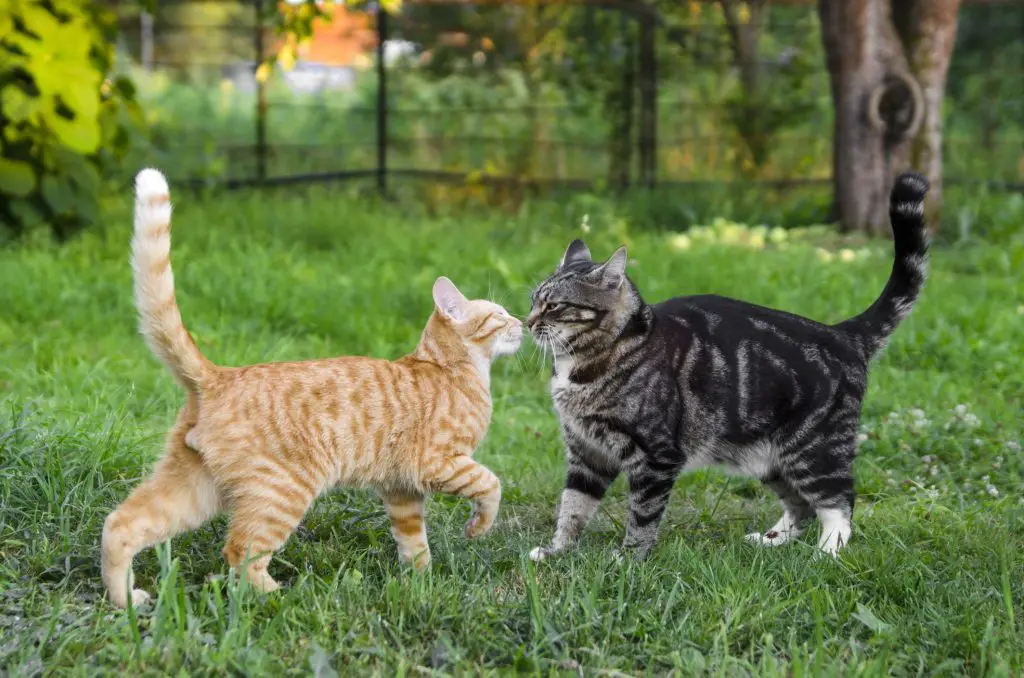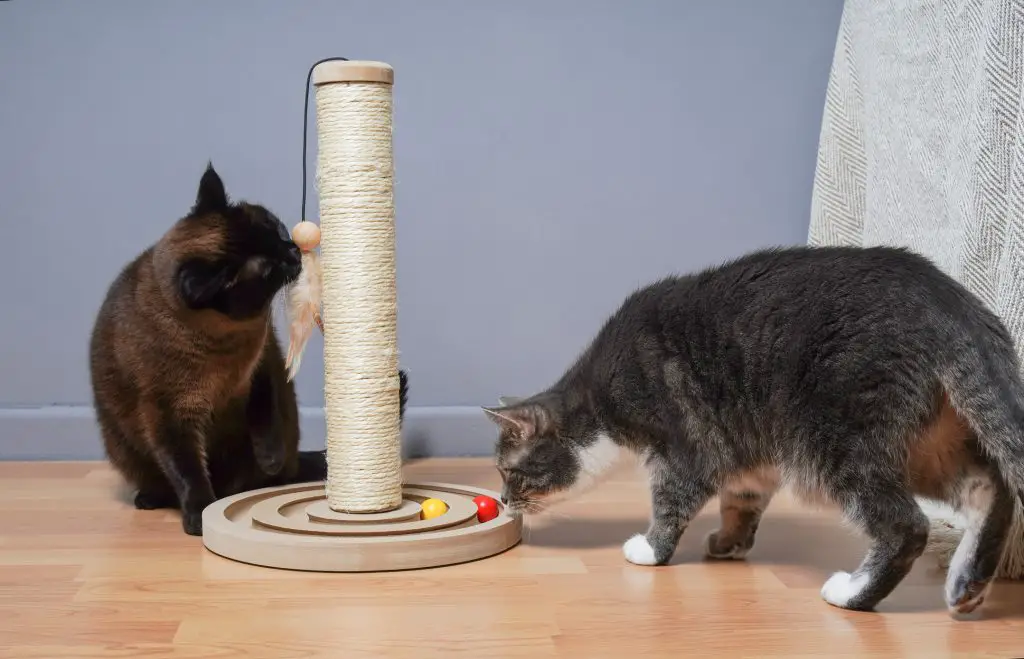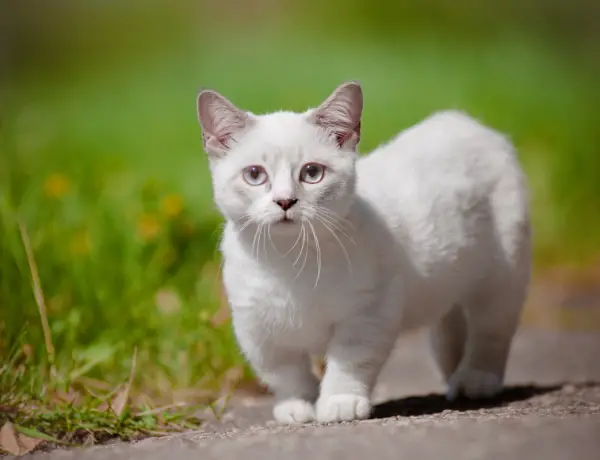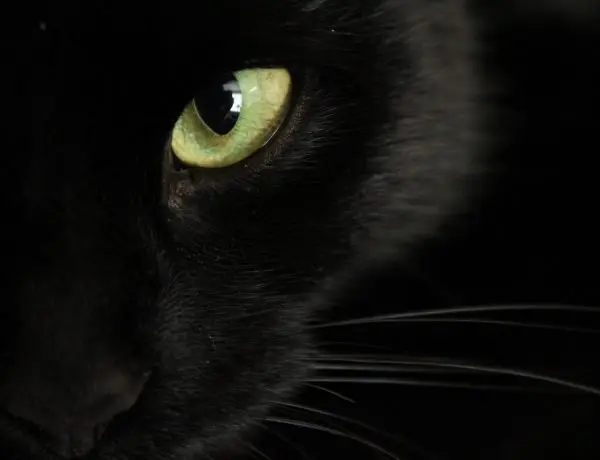Cats can be rather intense whether they are playing or fighting, and it may sometimes be difficult to determine which of these is happening. Luckily there are some specific body movements, sounds, and mannerisms to look for that can signal to you when cats are preparing to fight.
You can tell that cats are fighting by their bodies’ tenseness, the aggressiveness of their actions, and their vocal sounds. Although cats may sometimes play rough, their bodies will remain relaxed, and they will be gentler when they are playing in a reciprocating manner with one another.
Every part of a cat’s body behaves differently when the cat is playing as opposed to when it is in attack mode and ready to fight. From their retractable claws to their bushy tails and cute meows, cats can quickly transform from cuddly kittens to vicious felines. This can make introducing cats to one another a nerve-racking experience, but with an educated eye and a few tricks, you will be able to ease the anxiety and see if two cats will get along well before they ever get their claws out.
Table of Contents
What Determines If Cats Will Play or Fight?
Cats can be extremely territorial by nature and may not easily welcome new cats into their circle of existence. If another cat enters their domain, gets close to their food source, or otherwise intrudes their space, they may quickly become defensive and go into attack mode. For this reason, introducing new cats into a household can sometimes prove to be a difficult task.
Cat owners can help ease the process of getting to know and accept one another by understanding certain behavioral traits about cats. Taking careful steps during the introduction process can help to create a friendly and comforting environment that will teach both cats that they belong and that there is no need to defend their resources or themselves from one another.
Physical Difference Between Playing and Fighting Cats
Not only is the new cat on edge because it is in entirely new surroundings, but the cat who has already been living in this home will also instantly recognize this new cat as an intruder. When introducing a new cat into a household, it is important to do so gradually so that you can observe both cats’ behaviors.
There are several distinct physical differences that can be seen when cats are fighting instead of playing. Knowing these signs will help you understand what’s happening so that you, as a cat owner, can be an effective mediator.
| Cats Fighting | Cats Playing | |
|---|---|---|
| Claws | Cats usually keep their claws retracted, but when cats are getting ready to fight, they prepare their weapons. If you can see the ten little daggers out on a cat’s front paws, then be aware that it is not playing anymore. | Cats can play pretty rough at times, but if they don’t fear any physical danger, then there is no need to flaunt or use their claws. Although playing cats may sometimes swat with their paws, they keep their claws retracted when they don’t intend to do any physical harm. |
| Fur | When cats feel threatened, something called piloerection happens, which fluffs their fur up to make them look much bigger than they actually are. This will occur across the whole body but is particularly visible as a ridge along the spine. | When a cat is in play, it will be relaxed and will have no need to raise its fur. |
| Ears | When cats feel threatened, they tend to push their ears back to lay flat against their heads as a defense mechanism. Although they may lay their ears down in a similar fashion when they are relaxed and perhaps being pet, it is a noticeably forced gesture when the cat is being attacked. | Cats will generally keep their ears at their regular upright position when they are comfortable and at play or will otherwise not force them into any particular position. |
| Tail | Tails are a tell-tale sign of a cat being aggressive. When the fur on a cat’s tail stands up, it creates a poof that looks similar to a bottle brush. Furthermore, cats will begin whipping their tails around to fend off enemies. | Cats in the play don’t stiffen or strain their tail but rather keep it loose and lanky without any need to use it as a means of defense. |
| Eyes | Cats who are getting ready to fight will intensely stare down their opponent. A cat may be getting ready to fight if it fixes its eyes on another cat and shows any other signs on this list. | Cats in play may fix their eyes on another cat and pounce, but this will usually be distinctively light and playful and will not be intensely held in concentration. |
| Stance | Cats getting into a fight will often assume a tense stance with a sharp arch in their spine, and all four legs extended long. This stance will demonstrate the piloerection and brush-tail at their maximum extents. Cats will also tend to lean backward, ready to pounce, when in a defensive stance. | There is no particular stance that cats get into when they are playing. They will generally lean forward in a non-hesitant manner, and they may be dominant or submissive, run, pounce, swat, surprise, or go onto their hind legs. As long as they appear playful and relaxed, then they are likely getting along. |
| Vocal Sounds | Frequent hissing is a sign that cats may not be getting along. Although a hiss can occur during playtime due to one cat overstepping or a misunderstanding, consistent hissing is a likely sign that the cats are not at play. | Playing cats will often meow or purr. Although an infrequent hiss may occur during play as a warning from one cat to another, it is nothing to worry about unless this hissing increases in frequency. |
| Mannerisms | If one cat is always the chaser or aggressor and the other is always the one fleeing, this may be a clear sign that the cats are not engaging playfully. Cats tend to go back and forth in play, and although one cat may be more aggressive by nature, one cat constantly acting out that position makes it likely that it is actually picking on the other. | Cats will generally reciprocate play, meaning that all cats, at times, will take both the dominant and the submissive role. So long as cats show reciprocation, it is likely that they are being playful with one another. |
Hostile Situations That May Result in Cat Fights
There are certain circumstances in which pet owners can be wise in foreseeing catfights. These situations involve commonly observed protective and territorial traits that cause cats not to be welcoming to newcomers. Some of these situations include the following:
- Maternal: As with most species, mother cats are very protective and may want to fight any cat that comes near or otherwise appears as a threat to her litter. Mother cats may even become aggressive towards cats that they were friendly with before but will usually relax once the litter is weaned.
- The Old and the Young: Older cats are sometimes not up to playing with high-energy kittens and may not be patient enough to put up with them either. If a young kitten is introduced into a household where an elderly cat has lived alone for many years, it is common to see the older cat not be welcoming to the kitten. The older cat is likely to feel that the kitten is intruding upon its space and may see it as an annoying new roommate.
- Cats Who Have Always Been an Only Cat: Our pets are still largely driven by natural survival instincts, and newcomers are often treated with hostility because they are deemed a threat to the necessities and luxuries that they are accustomed to receiving, such as food, water, their litter box, and toys. Although this instinct runs through all animals to varying extents, cats can get used to sharing a space with others. However, those who have never before had an opportunity to develop those social skills may have a hard time accepting another into its space, and they may act hostile and aggressive towards a newcomer.
Tips for Introducing New Cats into a Household
Cats generally don’t care much for change, so easing them into a meeting with another cat can help relieve the pressure and stress of the process. Going about the meeting in a certain way will alleviate the stress for the cat and help the humans prevent an unwelcome scenario from escalating into a catfight.

Patience is a person’s best tool when introducing two cats, along with the above knowledge of what to look for to figure out how the cats are accepting each other. If the meeting is rushed or unsupervised, both cats will likely feel overly stressed by the confrontation and may act out on their survival instincts.
Be sure to create a schedule and environment that the cats can get used to, which would likely mean synching the new cat’s schedule with what is already established with the first cat. Also, be sure that there are more than enough resources to go around for both cats so that there is no need for one to feel like it needs to hoard things from the other. These resources include not only food and water but also litter space/litter boxes, beds, cat trees, toys, and overall space.
- The Set-up: You can facilitate this by introducing each cat’s smell to the other. This way, they will already have a sense of knowing and familiarity when the actual cat is introduced. One way to do this is to rub them both with the same towel, going back and forth so that each cat smells the other first separately and then intermixed with its own smell. Cats can also be kept in separate rooms for several days, hearing, smelling, and getting used to the presence of one another through the doors without ever seeing each other. If they seem up for it, they can even play with one another through the gap under the door. This technique can significantly help relieve the stress of the initial meeting because they will, to some extent, already have become familiar with each other. It can also be furthered by switching the cats into each other’s areas after a few days so that they can get even more used to the smell of the other cat in various parts of the house.
- The Viewing: Once the cats have a sense of one another and if they don’t seem aggressive or hostile towards one another, it is okay to let them see each other, though preferably still from a distance. One way to do this is through screen doors, baby gates, or other similar barriers. It may help to give treats or to undertake feeding times near this barrier so that the cats can get accustomed to eating their food in the presence of another without the threat of the other taking their food away from them.
- The Meeting: When two cats are first allowed to interact, it is critical to observe their behaviors and mannerisms. Allow them to check each other out, but it would also be smart to have a spray bottle of water prepared in case a fight suddenly ensues. So long as they don’t get aggressive, you should encourage play with both of them, preferably using two separate toys at first so they don’t need to fight over it and can’t steal the toys away from each other. Creating this comfortable feeling will help ease them into being able to view each other as playmates who can play with one another.

Cats may lay somewhere between these two scenarios, where they don’t necessarily fight, but they also aren’t best pals right away. This is okay and relatively normal, so don’t be discouraged. However, do continue to observe their interactions, make sure that one cat is not picking on the other, and that there is some degree of reciprocation if they do play.
For more tips and some visual examples of how to carry these steps out, check out this fun and informative video by Jackson Galaxy.
Facilitating a positive first meeting will leave a good first impression, something that could make or break the relationship between two cats. It often takes cats months or years to actually become playmates (if they ever do), but a negative first impression will almost certainly ruin any chances of the cats getting along.
If two cats are introduced to each other using these steps, but they can’t seem to get along, it may be time to look into some professional help.
Some useful organizations for those who need further help with their cats include the following:
- American College of Veterinary Behaviorists International Association of Animal Behavior Consultants
- Certified Applied Animal Behaviorists
Breaking Up A Cat Fight
Catfights can be loud, fast, and involve a lot of sharp teeth and claws, so breaking up a catfight is not an easy task. Jumping in the middle of a catfight or trying to pull one cat off the other can be quite dangerous if the cats do not instantly stop. However, a catfight can lead to severe injuries, so cat owners are also not encouraged to just let their cats have at it. Instead, there are certain things we can do without getting directly involved that will distract the cats from their fighting long enough for them to be separated until they are (hopefully) ready to get along again.
One such method is simply creating a loud noise, whether it’s done by yelling, clapping, banging on something, or using a training tool such as the Pet Corrector. If the cats aren’t necessarily out to get each other but somehow just escalated into a fight, a loud noise can be enough to startle them and disrupt the behavior.
If the cats are really going at it, you might try throwing towels or a big blanket over them. This should startle them enough to release one another long enough to be able to pick one of them up with the towel or blanket and move it into another room to cool down.
So long as this is not normal or frequent behavior between the two cats, then a brief twenty- or thirty-minute separation should usually clear the air and calm them down enough for them to go back to normal. However, if the cats seem to have created a permanent rift between themselves, then a complete re-introduction may be necessary to re-establish positive associations.
This article by the ASPCA offers other useful tips on dealing with cats who aren’t getting along.
In many ways, our beloved housecats still behave very similarly to their larger, wild counterparts. Although they may be content laying in a sink half the day between eating and playing, these cute and cuddly felines will still go into survival mode if they feel themselves, their children, or their livelihood threatened.
Cat owners can do a great deal in understanding the nature of their furry friends and by facilitating as stress-free of a meeting as possible. However, whether the cats will get along and how well your cats will welcome newcomers into the household will always still depend on each cat’s individual personality.




